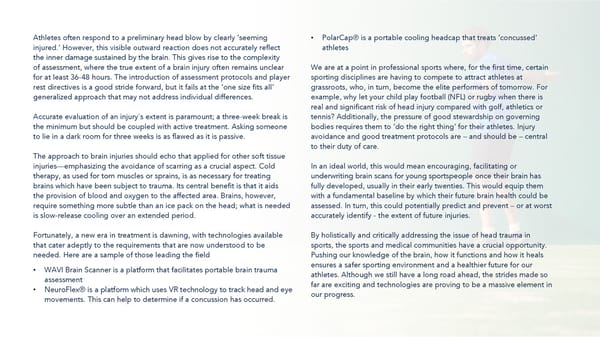Athletes often respond to a preliminary head blow by clearly ‘seeming • PolarCap® is a portable cooling headcap that treats ‘concussed’ injured.’ However, this visible outward reaction does not accurately reflect athletes the inner damage sustained by the brain. This gives rise to the complexity of assessment, where the true extent of a brain injury often remains unclear We are at a point in professional sports where, for the first time, certain for at least 36-48 hours. The introduction of assessment protocols and player sporting disciplines are having to compete to attract athletes at rest directives is a good stride forward, but it fails at the ‘one size fits all’ grassroots, who, in turn, become the elite performers of tomorrow. For generalized approach that may not address individual differences. example, why let your child play football (NFL) or rugby when there is real and significant risk of head injury compared with golf, athletics or Accurate evaluation of an injury's extent is paramount; a three-week break is tennis? Additionally, the pressure of good stewardship on governing the minimum but should be coupled with active treatment. Asking someone bodies requires them to ‘do the right thing’ for their athletes. Injury to lie in a dark room for three weeks is as flawed as it is passive. avoidance and good treatment protocols are – and should be – central to their duty of care. The approach to brain injuries should echo that applied for other soft tissue injuries—emphasizing the avoidance of scarring as a crucial aspect. Cold In an ideal world, this would mean encouraging, facilitating or therapy, as used for torn muscles or sprains, is as necessary for treating underwriting brain scans for young sportspeople once their brain has brains which have been subject to trauma. Its central benefit is that it aids fully developed, usually in their early twenties. This would equip them the provision of blood and oxygen to the affected area. Brains, however, with a fundamental baseline by which their future brain health could be require something more subtle than an ice pack on the head; what is needed assessed. In turn, this could potentially predict and prevent – or at worst is slow-release cooling over an extended period. accurately identify - the extent of future injuries. Fortunately, a new era in treatment is dawning, with technologies available By holistically and critically addressing the issue of head trauma in that cater adeptly to the requirements that are now understood to be sports, the sports and medical communities have a crucial opportunity. needed. Here are a sample of those leading the field Pushing our knowledge of the brain, how it functions and how it heals • WAVIBrain Scanner is a platform that facilitates portable brain trauma ensures a safer sporting environment and a healthier future for our assessment athletes. Although we still have a long road ahead, the strides made so • NeuroFlex® is a platform which uses VR technology to track head and eye far are exciting and technologies are proving to be a massive element in movements. This can help to determine if a concussion has occurred. our progress.
 The Sports Technology Annual Review 2023 Page 14 Page 16
The Sports Technology Annual Review 2023 Page 14 Page 16